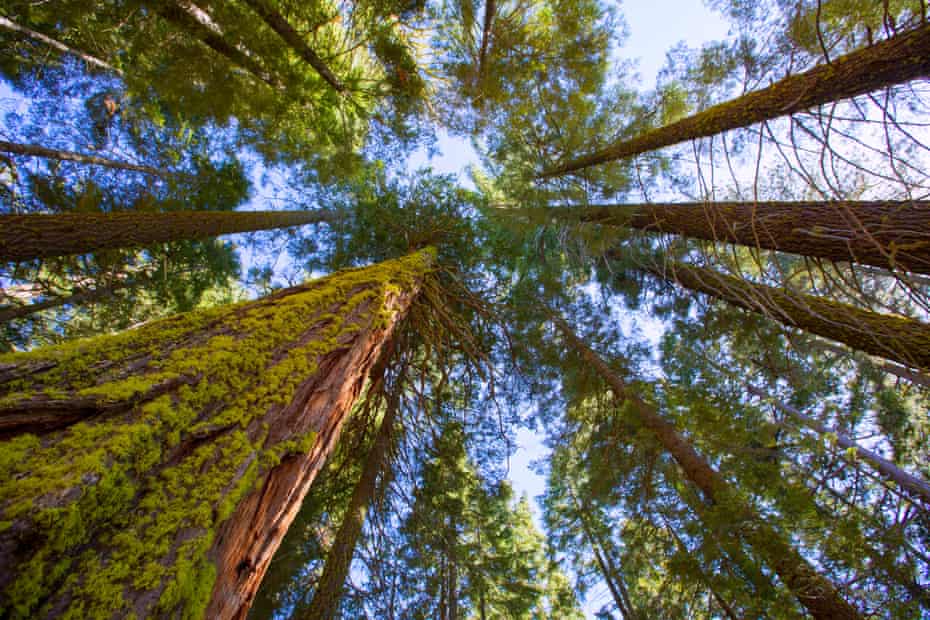
Hardly but we do need to do a better job of soil husbandry. Here the soils have become carbon depleted and the forest soils got burned out. Restoration should included mob grasing at least.
Not least is that the Great VAlley needs to become wetter and that means retaining what they have as best they can. That allows moisture into the hill sides and triggers growth.
The West is dehydrated and natural or not, its reversal is a plausible policy objective.
Is this the end of forests as we've known them?
Trees lost to drought and wildfires are not returning. Climate change is taking a toll on the world’s forests - and radically changing the environment before our eyes
by Alastair Gee
Wed 10 Mar 2021 08.00 GMT
https://www.theguardian.com/environment/2021/mar/10/is-this-the-end-of-forests-as-weve-known-them
Camille Stevens-Rumann never used to worry about seeing dead trees. As a wildland firefighter in the American west, she encountered untold numbers killed in blazes she helped to extinguish. She knew fires are integral to forests in this part of the world; they prune out smaller trees, giving room to the rest and even help the seeds of some species to germinate.
“We have largely operated under the assumption that forests are going to come back after fires,” Stevens-Rumann said.
But starting in about 2013, she noticed something unsettling. In certain places, the trees were not returning. For an analysis she led of sites across the Rocky Mountains, she found that almost one-third of places that had burned since 2000 had no trees regrowing whatsoever. Instead of tree seedlings, there were shrubs and flowers.
This shift – echoed across a warming world – is a distinct phenomenon from trees dying because of direct human intervention such as logging. These trees are dying without humans laying a hand on them, at least physically, and they are not resprouting. Forests cover 30% of the planet’s land surface, and yet, as humans heat the atmosphere, some locations where they would have grown now appear too dry or hot to support them.

Sequoias at Mariposa Grove of Yosemite, California. Sequoias are dying in remarkable numbers. Photograph: Natureworld/Alamy
In western North America, huge swaths of forested areas may become unsuitable for trees owing to climate change, say researchers. In the Rocky Mountains, estimates hold that by 2050, about 15% of the forests would not grow back if felled by fire because the climate would no longer suit them. In Alberta, Canada, about half of existing forests could vanish by 2100. In the south-western US, which is experiencing a “megadrought”, as much as 30% of forests are at risk of converting to shrubland or another kind of ecosystem.
“Now’s a good time to go visit national parks with big trees,” said Nate McDowell, an earth scientist at the Pacific Northwest National Laboratory and the lead author of a paper forecasting that in southwestern US forests more than half of conifers, the dominant type of trees, could be killed by 2050. “It’s like Glacier national park – now’s a good time to see a glacier before they’re gone.”
The change isn’t unique to the US and Canada. In the Amazon, some experts warn that a forest mortality tipping point is looming. The boreal forests of Siberia are under attack from higher temperatures. Temperate European forests thought to be less vulnerable to climate change are showing worrying symptoms.
Forest mortality researchers say while this does not mark the end of the forests, it may well be the end of many forests as we’ve known them. Iconic species such as giant sequoias and Joshua trees are succumbing in remarkable numbers. The landscapes of beloved wild places and national parks are, in turn, being transformed. And the changes being observed today – in which slow-growing trees that have survived for hundreds of years are dying in a drought or wildfire – cannot be undone in our lifetimes.
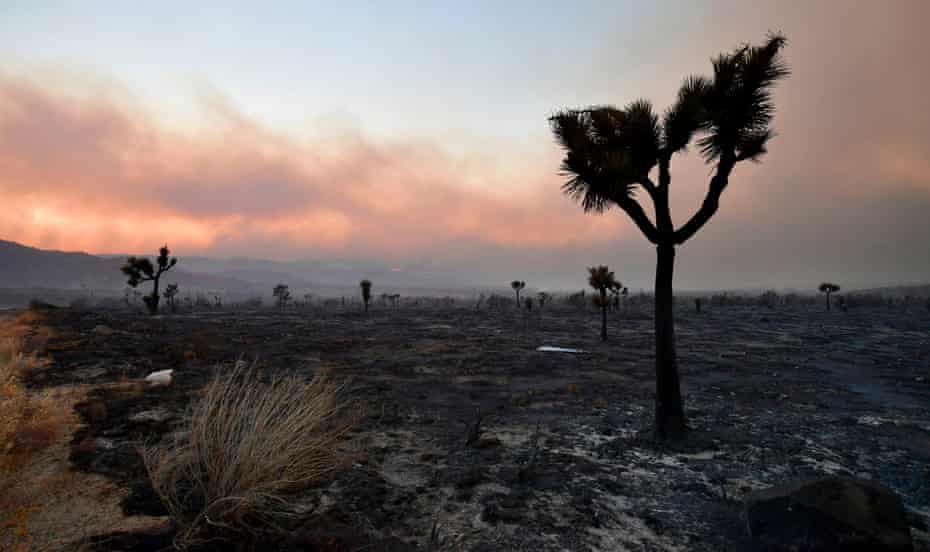
Fire-ravaged Joshua trees are seen on a scorched landscape after the Bobcat fire in September 2020 in Juniper Hills, California. Photograph: Frederic J Brown/AFP/Getty Images
“You realize in some ways how short our lives are in comparison to these ecosystems,” said Stevens-Rumann, a fire ecologist at Colorado State University. “I’m never going to see these landscapes again.”
The possibility of worldwide mass forest mortality linked to climate change was flagged in the first Intergovernmental Panel on Climate Change assessments in 1990. But today, many researchers are expressing particular concern about the tree mortality crisis building in California and other parts of the west.
Since 2010, 129m trees are estimated to have died in California’s national forests, as a result of a hotter climate, insects and other factors. Astonishingly, 48.9% of all trees in a comprehensive study of the southern Sierra Nevada mountain range were killed.
The effects of a warming planet on trees were already obvious in summer 2016, as California was emerging from its driest four-year period since scientific record-keeping began. In August that year, I drove from San Francisco to the foothills of the Sierra Nevada to visit Steven Ostoja, the director of the US agriculture department’s California Climate Hub. At his house on the rural outskirts of a community called Oakhurst, Ostoja led me into his yard.

A boardwalk in the Mariposa Grove in Yosemite damaged by a fallen ponderosa pine during the Mono wind event on 19 January. Photograph: AP
“I watched that tree die,” he said, gesturing toward a 40ft-tall ponderosa pine. We crunched across yellowed grass and leaves to examine it. The ponderosa was wizened and bleached by the elements. Up close, Ostoja was able to pull off a chunk of bark as easily as peeling a tangerine. He pointed out dozens of small holes along the bark made by burrowing beetles. Small, hard blobs of pitch, resembling honey, indicated where the tree had tried to push them out, but lacking water, it had not been able to produce enough.
Dehydration is not always the culprit when trees die in droughts. Droughts often create such hostile conditions that trees with decades or centuries of life ahead of them are suddenly vulnerable to insects or disease, or to wildfires that can rampage when the environment dries out.
The distant whine of a chainsaw taking down a dead tree served as a reminder of the extent of the problem. “That’s a sound you hear all the time,” Ostoja said. “You’ll hear it on a Monday, on a Tuesday, all day long.”
Ostoja had an unruffled scientific manner, but even so he was perturbed by the speed of the change he had witnessed. “It wasn’t within a career,” he said. “It was within three years.” He wondered aloud whether this was one of the most pronounced ecological shifts in the western US “in such a short period of time in the last 10,000 years”.
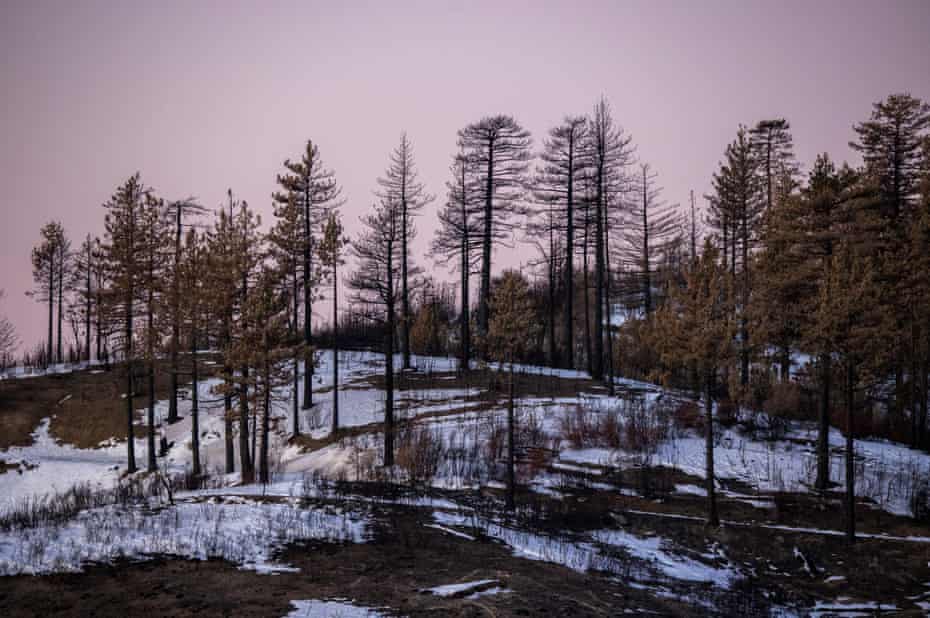
Burned trees are seen after the first winter storm of the season drops snow on the Bobcat fire scar in the Angeles national forest near Azusa, California, on 31 December 2020. Photograph: David McNew/Getty Images
Researchers acknowledge that there is considerable ambiguity in their predictions about tree mortality. For one thing, it is unclear how many of the trees now dying essentially weren’t meant to be there in the first place. Western forests are denser than they were historically because of human influence: the practice of tamping out wildfires, beginning in the early 20th century, has interfered with a natural process in which blazes weed out younger trees and undergrowth.
Even so, the tree mortality problem spanning the western part of the continent is prompting a broad and looming sense of disquiet. Take New Mexico, which has just experienced one of its driest two-decade periods in 1,200 years. At Bandelier national monument, recent wildfires have left bare landscapes. “Why aren’t we getting pine regeneration?” the monument’s chief resource manager said to the Durango Herald in 2017. “We may have to redefine recovery, because we’re not sure some of these forest types will ever return.”
Not far away, ecologist Craig Allen just marked his 40th year studying forests and landscapes in the Jemez mountains. When he arrived from the cooler climes of north-east Wisconsin, moist weather patterns made the region “a great place to be a tree in the south-west US”. That natural variability has now, thanks to climate change, flipped to megadrought conditions. By mid-century, Allen suspects, trees will barely cling to existence in the mountains of the south-west.

A series of photographs taken in 2011, 2013 and 2014 by researcher Craig Allen in the footprint of the Las Conchas fire, a 2011 ‘megafire’ in the eastern Jemez mountains. The images show little tree regrowth. Composite: Craig Allen
“I have to be a little careful about not sounding like some Cassandra saying the sky is falling and forests are going to die and burn – but I have seen what that looks like,” said Allen, who founded the US Geological Survey’s New Mexico Landscapes Field Station.
On a personal level, he added, “it’s actually disorienting to me to be out in the landscapes in some ways because they’re so different from how I first knew them. Now you see a vista literally for 100 miles – you see the next mountain range 100 miles away. And [previously] you couldn’t see more than 20 meters. The canopies are thin, the whole productivity and vigor of the system is suppressed.”
Around the globe, research has suggested that the tree mortality rate in some temperate and tropical forests has doubled or more in recent decades.
While in some places there will be wholesale tree die-offs as a result of climate change, in other places it will alter the very composition and feel of forests. They will not be what they were.
In the Amazon, climate change has lengthened the dry season and caused the rainfall to decline in parts. These shifts are reorganizing the forest: trees that prefer drier conditions are thriving, while those that prefer wetter conditions, and which make up the majority of tree species in Amazonia, are dying off in greater numbers, a study has found.
These changes demonstrate just how far-flung the impacts of climate change can be. The Amazon “is one of the most remote places on Earth”, said lead author Adriane Esquivel Muelbert, a lecturer at the University of Birmingham and researcher at the Birmingham Institute of Forest Research. “Humans are managing to change the environment even very far away from where they are living, or most of them are living.”
With the combined impacts of global heating and rampant logging, some researchers warn that large parts of the rainforest ecosystem could collapse and convert to savanna. “Today, we stand exactly in a moment of destiny,” two leading academics declared in a 2019 editorial. “The tipping point is here, it is now.”
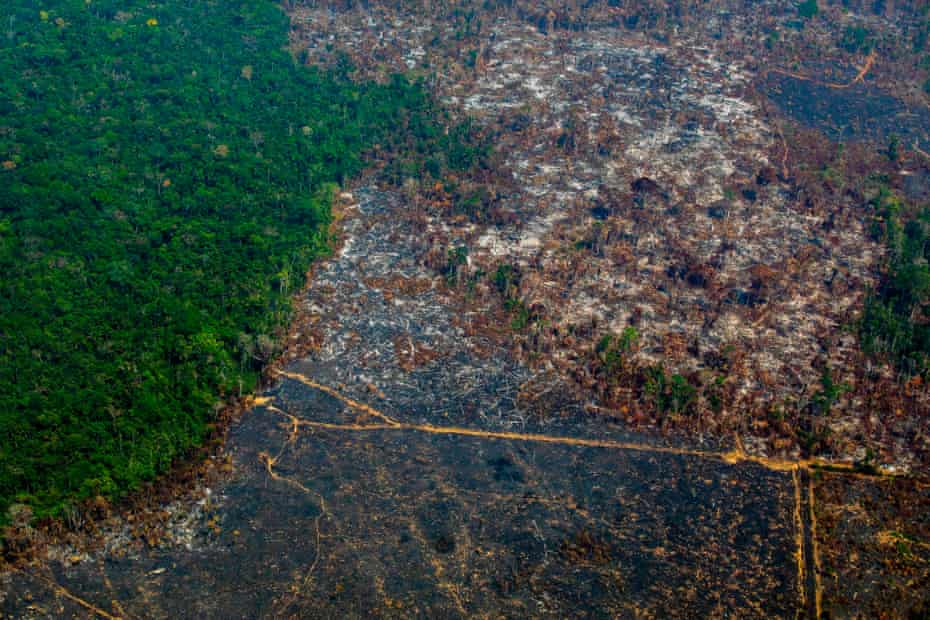
An aerial view of deforestation in Nascentes da Serra do Cachimbo Biological Reserve in Brazil’s Amazon basin in August 2019. Photograph: João Laet/AFP/Getty Images
Cooler regions are not immune. Boreal forests ringing the northerly parts of the globe are in fact projected to experience the greatest warming of all. In central Siberia, conifers are already dying at greater rates and are expected to retreat upslope and to the north. One boreal forest researcher told Yale Environment 360 that “the boreal forest is breaking apart.” He added: “The question is what will replace it?”
Even forests thought more impervious to climatic shifts are proving not to be. In Austria, Germany and Switzerland, heat and low rainfall in 2018 caused mass mortality among species such as Norway spruce and European beech. The German government estimated that at least 2,450 square kilometers would need to be reforested.
“It was a really impressive period, the last two years, because so far I’d only known large-scale mortality events from the literature,” said Henrik Hartmann, co-author of a study on the die-off and an organizer of the International Tree Mortality Network. “And now it is actually here in a very temperate region where nobody would expect it.”
A great irony of this shift is that trees are dying just as we understand them better than ever. It has become clear that far from being inert and silent, and little more than a backdrop for wildlife, trees are able to communicate with one another and even share resources.
Forests also absorb around one-quarter of all human carbon emissions annually, and increasingly there are worries that if forests die back they will switch from storing carbon to emitting it, because dead trees will release all the carbon they have accumulated. This helps explain why much-touted proposals to plant millions of trees to suck up carbon and ameliorate the climate crisis are encountering skepticism; they won’t work if conditions on Earth don’t allow for forests to reproduce and thrive.
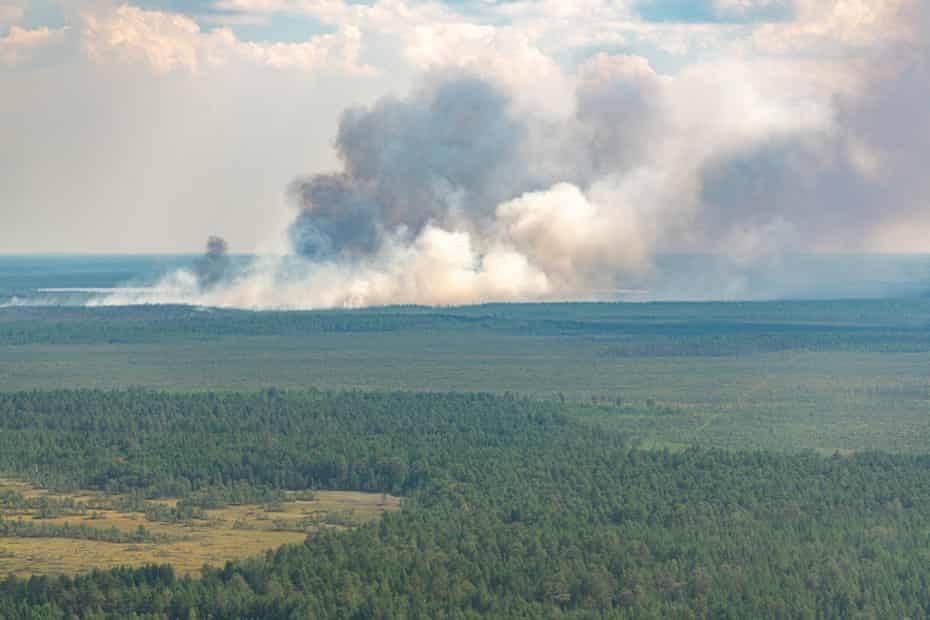
An aerial view of a wildfire in the taiga in the Khanty-Mansi Autonomous Area, in north-west Siberia. The boreal forests of Siberia are under attack from higher temperatures. Photograph: Denis Bushkovsky/Tass
It is true that forests could find new footholds in places that were formerly too cold or otherwise unsuited to them. But trees can take centuries to reach maturity, and in terms of global heating, older, large trees store much more carbon than younger, smaller ones. Instead of focusing on new trees, researchers say, the best answer to the mortality crisis is to preserve the forests we already have – by cutting carbon emissions.
For Camille Stevens-Rumann, the fire ecologist studying tree mortality in the Rockies, watching these changes in places she has known for years – and where she has backpacked and rafted – has required an adjustment.
“As a person who loves trees and has spent my career so far looking predominantly at trees, it is a bit of a stark difference and a shift of mindset to think about these landscapes as not ‘treed’ for a longer period of time – or indefinitely,” she said.
Even so, she is able to find beauty in them, and in what humbler plants are able to make a comeback even if the pine and fir trees cannot. She is a realist. Life marches on.
“This is the beginning of a new ecological state.”
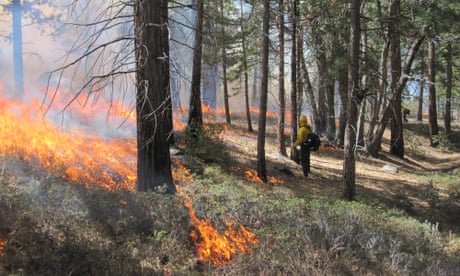
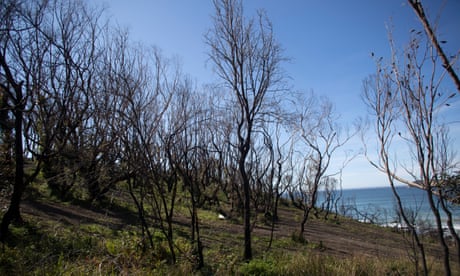
No comments:
Post a Comment